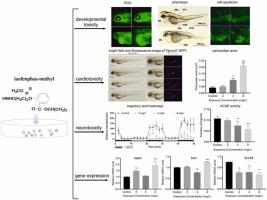Ecotoxicology and Environmental Safety ( IF 6.2 ) Pub Date : 2023-03-03 , DOI: 10.1016/j.ecoenv.2023.114723 Yuanzhao Wu 1 , Jiawen Wang 1 , Yumei Xia 1 , Kaiqin Tang 1 , Jincheng Xu 1 , Anli Wang 2 , Shundi Hu 3 , Luhong Wen 3 , Binjie Wang 1 , Weixuan Yao 1 , Jiye Wang 1

|
Isofenphos-methyl (IFP) is widely used as an organophosphorus for controlling underground insects and nematodes. However, excessive use of IFP may pose potential risks to the environment and humans, but little information is available on its sublethal toxicity to aquatic organisms. To address this knowledge gap, the current study exposed zebrafish embryos to 2, 4, and 8 mg/L IFP within 6–96 h past fertilization (hpf) and measured mortality, hatching, developmental abnormalities, oxidative stress, gene expressions, and locomotor activity. The results showed that IFP exposure reduced the rates of heart and survival rate, hatchability, and body length of embryos and induced uninflated swim bladder and developmental malformations. Reduction in locomotive behavior and inhibition of AChE activity indicated that IFP exposure may induce behavioral defects and neurotoxicity in zebrafish larvae. IFP exposure also led to pericardial edema, longer venous sinus-arterial bulb (SV-BA) distance, and apoptosis of the heart cells. Moreover, IFP exposure increased the accumulation of reactive oxygen species (ROS) and the content of malonaldehyde (MDA), also elevated the levels of antioxidant enzymes of superoxide dismutase (SOD) and catalase (CAT), but decreased glutathione (GSH) levels in zebrafish embryos. The relative expressions of heart development-related genes (nkx2.5, nppa, gata4, and tbx2b), apoptosis-related genes (bcl2, p53, bax, and puma), and swim bladder development-related genes (foxA3, anxa5b, mnx1, and has2) were significantly altered by IFP exposure. Collectively, our results indicated that IFP induced developmental toxicity and neurotoxicity to zebrafish embryos and the mechanisms may be relevant to the activation of oxidative stress and reduction of acetylcholinesterase (AChE) content.
中文翻译:

甲基异苯磷对斑马鱼胚胎发育的毒性作用
甲基异苯磷 (IFP) 被广泛用作有机磷,用于控制地下昆虫和线虫。然而,过度使用 IFP 可能对环境和人类构成潜在风险,但关于其对水生生物的亚致死毒性的信息很少。为了解决这一知识差距,目前的研究将斑马鱼胚胎在受精后 6-96 小时内暴露于 2、4 和 8 mg/L IFP,并测量了死亡率、孵化、发育异常、氧化应激、基因表达和运动能力活动。结果表明,IFP 暴露降低了胚胎的心率和存活率、孵化率和体长,并诱发未充气的鱼鳔和发育畸形。运动行为的减少和 AChE 活性的抑制表明 IFP 暴露可能会导致斑马鱼幼虫的行为缺陷和神经毒性。IFP 暴露还导致心包水肿、静脉窦-动脉球 (SV-BA) 距离变长以及心脏细胞凋亡。此外,IFP暴露增加了活性氧(ROS)的积累和丙二醛(MDA)的含量,也提高了超氧化物歧化酶(SOD)和过氧化氢酶(CAT)的抗氧化酶水平,但降低了谷胱甘肽(GSH)水平斑马鱼胚胎。心脏发育相关基因的相对表达量(IFP暴露增加了斑马鱼胚胎中活性氧(ROS)的积累和丙二醛(MDA)的含量,也提高了超氧化物歧化酶(SOD)和过氧化氢酶(CAT)的抗氧化酶水平,但降低了谷胱甘肽(GSH)水平. 心脏发育相关基因的相对表达量(IFP暴露增加了斑马鱼胚胎中活性氧(ROS)的积累和丙二醛(MDA)的含量,也提高了超氧化物歧化酶(SOD)和过氧化氢酶(CAT)的抗氧化酶水平,但降低了谷胱甘肽(GSH)水平. 心脏发育相关基因的相对表达量(nkx2.5、nppa、gata4和tbx2b)、凋亡相关基因(bcl2、p53、bax和puma)和鱼鳔发育相关基因(foxA3、anxa5b、mnx1和has2)被 IFP 暴露显着改变. 总的来说,我们的结果表明 IFP 对斑马鱼胚胎产生发育毒性和神经毒性,其机制可能与氧化应激的激活和乙酰胆碱酯酶 (AChE) 含量的降低有关。































 京公网安备 11010802027423号
京公网安备 11010802027423号